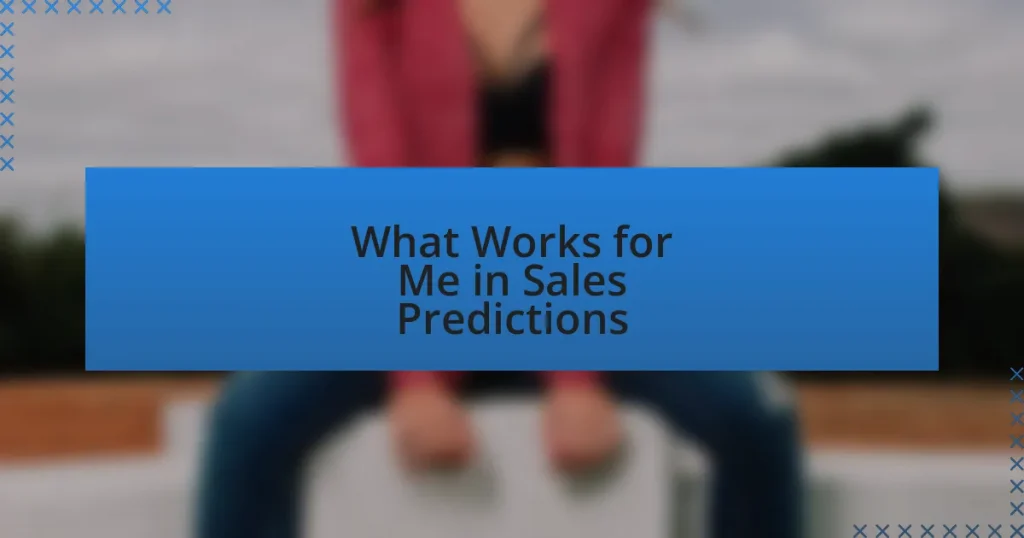Key takeaways:
- Sales predictions are crucial for understanding consumer sentiment, market trends, and aligning with customer values, especially in the fashion industry.
- Accurate sales forecasting enhances inventory planning, reduces waste, and helps capture emerging market opportunities.
- Key factors for effective predictions include analyzing historical data, understanding consumer behavior, and monitoring competitors.
- Utilizing tools like data analytics software, CRM systems, and social media analytics can significantly improve the accuracy of sales predictions.
Author: Charlotte Hawthorne
Bio: Charlotte Hawthorne is an acclaimed author known for her compelling storytelling and richly drawn characters. With a passion for exploring the complexities of human relationships, her novels often blend elements of romance, intrigue, and self-discovery. A graduate of the University of California, Charlotte has received multiple awards for her work, including the prestigious Silver Quill Award. When she’s not writing, she enjoys hiking in the Sierra Nevada mountains and sipping coffee at local cafes. Charlotte currently resides in San Francisco with her rescue dog, Jasper.
Understanding sales predictions
Sales predictions are more than just numbers; they reflect the pulse of consumer sentiment and market trends. I remember when I first started analyzing sales data for my fashion line. I was surprised to see how much the buying patterns shifted based on seasonal changes and even social media buzz. Have you ever wondered how a single trending outfit can turn into a sold-out phenomenon overnight?
To truly understand sales predictions, one must look beyond the surface. It’s about recognizing patterns and anticipating what customers will want next. For instance, the rise of sustainability in fashion has informed many of my predictions. I’ve seen how customers are increasingly drawn to eco-friendly brands, shifting their purchasing habits, which in turn affects inventory decisions. It’s fascinating how aligning with consumer values can lead to more accurate predictions.
While historical data is helpful, the emotions tied to our fashion choices play a crucial role. Picture those moments when you felt an undeniable connection to a piece of clothing—it’s that same feeling that drives broader market trends. How can we possibly predict sales without considering what evokes passion in our customers? Emotional insights are key to turning raw data into meaningful predictions.
Importance of sales predictions
Sales predictions serve as a guiding light for businesses, helping to navigate the often unpredictable waters of the fashion industry. I remember attending a trade show where a brand shared their insights on forecasting. They emphasized how accurate predictions allowed them to plan inventory efficiently, which ultimately drove sales up and reduced waste. Isn’t it intriguing how effective planning can transform a business’s profitability?
Understanding future trends allows brands to stay one step ahead. I once underestimated the impact of a popular influencer on my product line, only to realize, too late, that timely predictions could have stocked my shelves before the demand skyrocketed. This experience taught me that sales forecasts are not just about numbers; they are the key to seizing market opportunities as they arise.
Moreover, sales predictions foster a deeper connection with customers by tailoring offerings to their needs. During a major fashion event, I customized a collection based on predictions that highlighted rising trends. Not only did customer engagement soar, but it also reinforced my belief that understanding what the market desires is essential. How can we ignore the power of knowing our audience? It’s this insight that not only drives sales but also builds lasting relationships in the fashion world.
Key factors in sales predictions
Sales predictions hinge on analyzing historical data and market trends. I recall a time when I meticulously tracked sales patterns during seasonal transitions, only to discover that certain colors consistently outperformed others. It’s fascinating how diving into the data can unveil insights that shape future collections and align them with what customers are actively seeking. Have you ever noticed how past successes can illuminate the path ahead?
Another key factor lies in understanding consumer behavior. I once launched a campaign based solely on gut feeling, only to find it didn’t resonate as expected. Conversely, when I surveyed my audience about their preferences and buying habits, the feedback transformed my approach. Engaging directly with customers not only provides valuable information but also builds trust. Isn’t it amazing how listening can lead to more successful interactions?
Lastly, keeping an eye on competitive dynamics can make a huge difference. I learned this lesson firsthand when I observed a rival brand’s strategy and adapted quickly. By tuning into what competitors were doing, I was able to pivot my offerings just in time to capture a shifting interest in sustainable fashion. Being aware of the bigger picture allows us to not only anticipate changes but also to respond proactively. How do you leverage your competitive environment in your predictions?
Tools for accurate sales predictions
When it comes to tools for accurate sales predictions, I find leveraging data analytics software indispensable. During my experience with a sales forecasting tool, I could visualize trends and spot anomalies that I would have otherwise missed. This software’s ability to sift through piles of data and reveal potential sales spikes before they happen is something I deeply appreciate. Have you ever experienced that moment of clarity when a tool helps illuminate the path ahead?
Another vital resource in my toolkit is customer relationship management (CRM) systems. I remember a time when I struggled to keep track ofCustomer interactions, but once I incorporated a CRM, everything changed. Suddenly, I had a treasure trove of information about customer preferences and buying patterns readily available. How powerful is it to utilize insights straight from your customer base to predict future sales accurately?
Lastly, I cannot overstress the value of social media analytics. I once analyzed engagement metrics from a campaign I ran on Instagram, and it completely transformed my understanding of our audience. The levels of interaction were eye-opening, guiding how I tailored my upcoming collections. Have you tapped into social media data to forecast trends in your own sales?
Tips for improving sales predictions
To enhance your sales predictions, honing your understanding of seasonal trends can be incredibly effective. I remember when I first recognized how sales would spike during certain fashion seasons. By closely tracking these cycles, I learned to prepare my inventory in advance, which minimized overstock and maximized profit. Have you ever noticed patterns in your own sales that correlate with seasonal shifts?
Another approach is to incorporate customer feedback into your forecasting. I once launched a line based on direct input from my customers, and the sales exceeded my expectations. It’s incredible how listening to your audience can provide insights that not only boost accuracy in predictions but also create a deeper bond with your clientele. Are you actively engaging with your customers to gather their opinions?
Finally, experimenting with A/B testing offers valuable insights into customer preferences. When I tested two distinct marketing strategies, the results revealed surprising insights about my audience’s buying behavior. Implementing the preferred approach helped me tailor my strategies and improve my sales forecasts. Have you tried A/B testing in your predictions, and if so, what did you learn?


